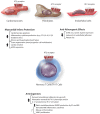Conflicting mechanisms of AT2 cardioprotection revealed
- PMID: 27659501
- PMCID: PMC5031951
- DOI: 10.1093/cvr/cvw199
Conflicting mechanisms of AT2 cardioprotection revealed
Figures

Comment on
-
The angiotensin II type 2 receptor activates flow-mediated outward remodelling through T cells-dependent interleukin-17 production.Cardiovasc Res. 2016 Oct;112(1):515-25. doi: 10.1093/cvr/cvw172. Epub 2016 Jun 21. Cardiovasc Res. 2016. PMID: 27328880
References
-
- Helisch A, Schaper W. Arteriogenesis: the development and growth of collateral arteries. Microcirculation 2003;10:83–97. - PubMed
-
- Zimarino M, D'Andreamatteo M, Waksman R, Epstein SE, De Caterina R. The dynamics of the coronary collateral circulation. Nat Rev Cardiol 2014;11:191–197. - PubMed
-
- Galis ZS, Khatri JJ. Matrix metalloproteinases in vascular remodeling and atherogenesis: the good, the bad, and the ugly. Circ Res 2002;90:251–262. - PubMed
Publication types
MeSH terms
Substances
Grants and funding
LinkOut - more resources
Full Text Sources
Other Literature Sources

